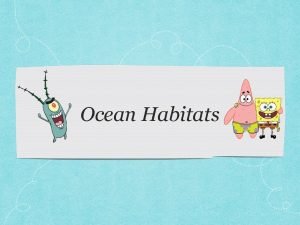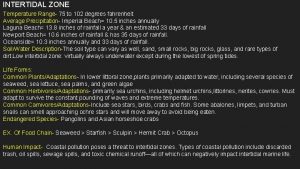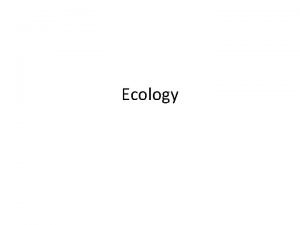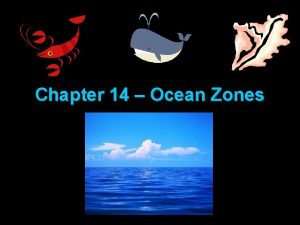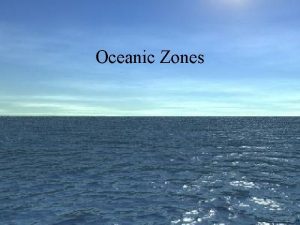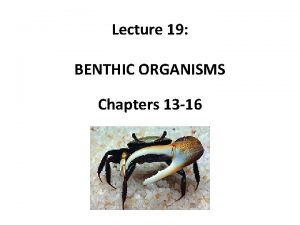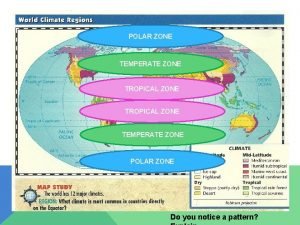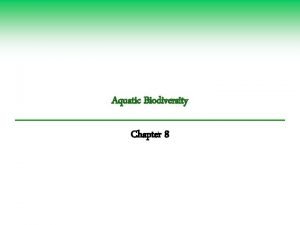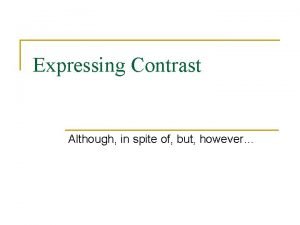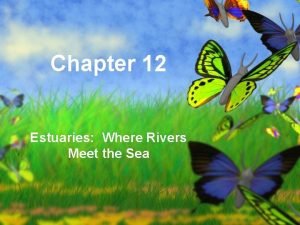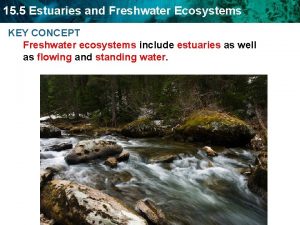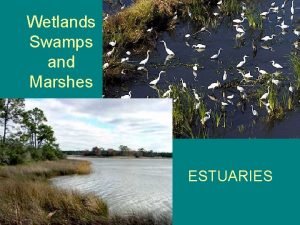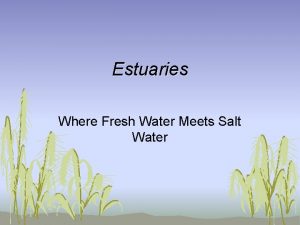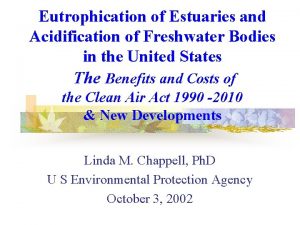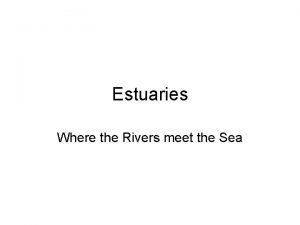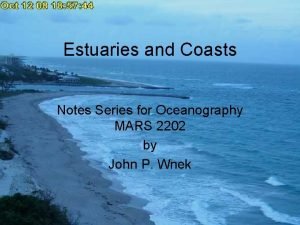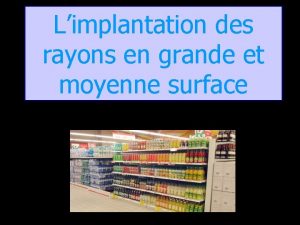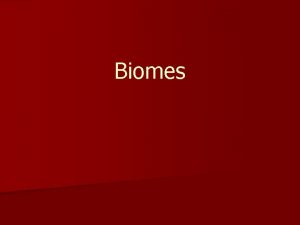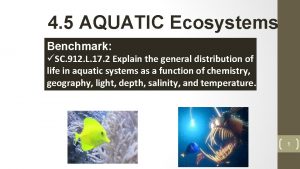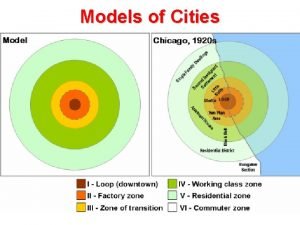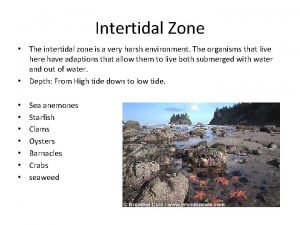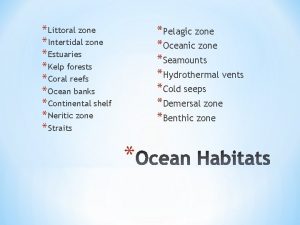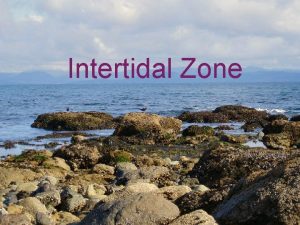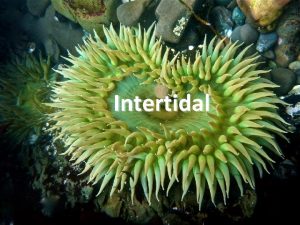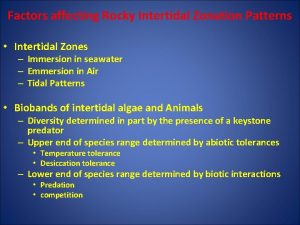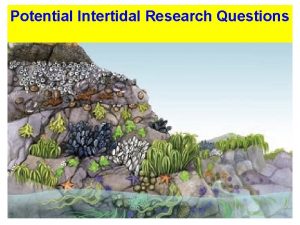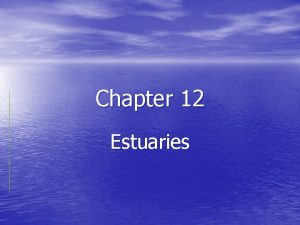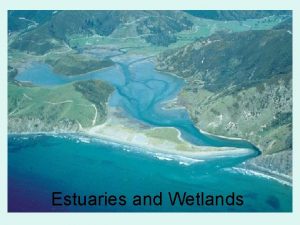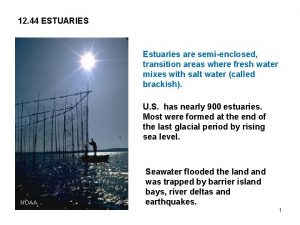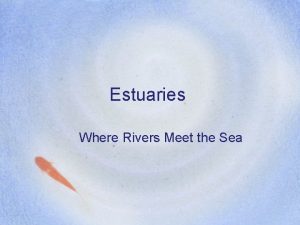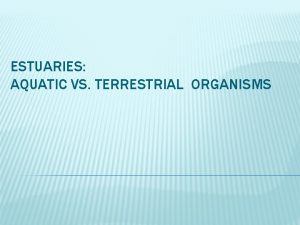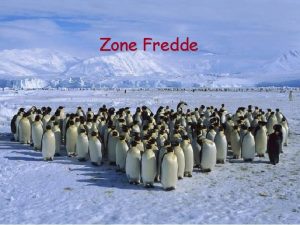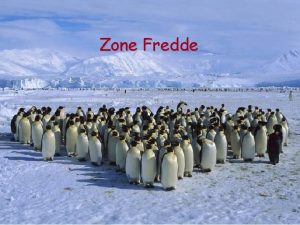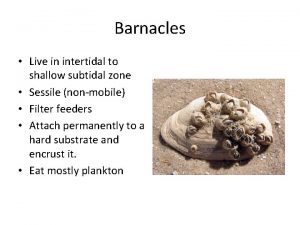ESTUARIES INTRODUCTION Whereas the intertidal zone place where
































- Slides: 32

ESTUARIES

INTRODUCTION • Whereas the intertidal zone place where terrestrial and the marine habitat meets, as estuary is a place where freshwater and salt water meet. • It is a transition zone between the two aquatic ecosystems. • Estuaries have been and remain close association with humans, because many of the major cities of the world are established on estuaries. • In contrast to other ecotomes or transitional areas, estuaries have few species of permanent organisms.

TYPES OF ESTUARIES There are many definitions of an estuary, because several morphological features of coastlines, such an lagoons, sloughs, fjords, and other shallow embayment's are often considered estuaries. A simple definition is that as estuary is a partially enclosed coastal embayment where freshwater and seawater meet and mix. This definition implies the free communication of the sea with the freshwater source, atleast during a part of the year. .

As a result of the geomorphology of an estuary, the geological history of the area, and the prevailing climatic conditions, there may be different estuarine types, each displaying somewhat different physical and chemical conditions. They are, • Coastal plain estuary • Tectonic estuary • Semi enclosed estuary or lagoon • Fjords

Coastal plain estuaries : This estuary were formed at the end of the last ice age when the rising sea level invaded low-lying coastal river valleys. E. g. Chesapeake Bay and the mouths of the Delaware and Handsome rivers in the United States and the Cornwall and Devon estuaries in Great Britain Tectonic estuary: In this class of estuary, the sea reinvades the land due to subsidence of the land, not as a result of a rising sea level. E. g. Sam Francisco Bay

semi enclosed bay or lagoon: Here sand bars build up parallel to the coastline and partially cut off the waters behind them from the sea. • This creates a shallow lagoon behind the sandbars, which collects the freshwater discharge from the land. • The water is such lagoons varies in salinity, depending on the climatic conditions, whether or not any major river flows into the lagoon, and the extent to which the bars restrict sea water access. • E. g. Such estuaries are common in north Caroline and along the Texas and Florids only coasts in north-western Europe (the Netherlands), and part of Australia.

Fjords : These are valleys that have been deepened by glacial action and are then invaded by the sea. • They are characterized by a shallow sill an the month that greatly restricts water interchange between the deeper waters of the fjord and the sea. • Often, these deeper waters are stagnant because of lack of circulation. • E. g. Fjords are abundant on the coasts of Norway, Chile, Scotland, Alaska, New Zealand British Columbia.

• Estuaries may be classified in yet another way he salinity gradients are formed. • In most estuaries, there is a gradient in salinity from full seawater (33 – 37 ppt (psu) at the month to freshwater at the upper reaches. POSITIVE ESTUARY OR SALT WEDGE ESTUARY : In estuaries where there is substantial freshwater outflows and reduced evaporation (typical temperate zone estuaries), the fresh water moves out over the top of the Salt Water, mixing with it near the surface and reducing the salinity, leaving the deeper waters more saline. • In such a situation, a cross section of the estuary shows isohalines (lines of equal salinity), which extend upstream at bottom. • These estuaries are also called river dominated (or) stratified.

NEGATIVE OR EVAPORITE ESTUARY : In desert climates, where the amount of freshwater input to the estuary is small and the rate of evaporation high, a negative (or) evaporate estuary results. In a negative estuary, the incoming salt water enters at the surface and is some what diluted by mixing with the small amount of freshwater. The high evaporation rate, however, causes this surface water to become hyper saline. Hyper saline water is denser than seawater, sinks to the bottom and moves out of the estuary as a bottom current. A salinity profile of such as estuary is the reverse of the positive estuary, with highest values at the bottom and lowest at the top.

SEASONAL (OR) INTERMITTENT ESTUARY: These estuaries are formed areas where there is a marked wet and dry season (Mediterranean climate). In the rainy season, they have freshwater input and are open to the ocean. In the dry season, they have no freshwater input, may become dry or stagnant, and are often cut off from the ocean by seasonal sandbars. Salinity in these e estuaries varies not spatially but temporally.

Physical Characteristics of Estuaries Salinity : The dominant feature of the estuarine environment is the fluctuation in salinity. A salinity gradient exists at some time in an estuary, but the pattern of that gradient varies with the seasons, the topography of the estuary the tides and the amount of freshwater. Where the tidal range is significant, high tide drives the salt water further up the estuary, displacing the isohalines upstream, low tides, by contrast, displace the isohaline down stream. As a result, a certain area of the estuary is subject to a salinity regione that changes with each tide

CORIOLIS EFFECT : The rotation of the earth deflects flowing water. In the Northern Hemisphere, this effect deflects outflowing freshwater to the right as one looks down the estuary toward the sea. Salt water flowing into the estuary from the ocean is also displaced to the right looking from the sea toward the estuary. The opposite is true in the Southern Hemisphere. As a result, two points, each on opposite sides of the estuary equidistant from the mouth, may have predictable different salinities.

SEASONAL CHANGES IN SALINITY : It is a result of seasonal changes in evaporation, freshwater flow, or both. In areas where freshwater discharge is reduced or absent for part of the year, higher salinities (salt wedge) may be found further upstream. With the onset of increased freshwater flow, the salinity gradients are moved down stream toward the month. At different seasons of the year, therefore, a given point in the estuary may experience different salinities.

Substrate : Most estuaries have soft, muddy substrates. These are derived from sediments carried into the estuary by both seawater and freshwater. When these suspended particles reach and mix with seawater in the estuary, the presence of the various ions in the seawater causes the silt particles. These particles settle out, forming the characteristic mud bottom. As a result, the particles settled out and contribute to the forming of the mud or sand substrate. The deposition of particles is also controlled by currents and the size of the particle.

Large particle settle out faster than small particles in suspension longer than slow currents. Catastrophic events may also play a significant role. Massive storms and their accompanying floods may produce large deposition or removal of sediment in estuaries, causing severe mortality of organisms. Among the particles that settle out in the estuary are terrestrial and marine organic matter. As a result, the substrate that accumulates is very rich in organic material. This material may serve as a large food reservoir for estuarine organisms

Temperature: Water temperatures in estuaries are more variable than in the nearby coastal waters. In part, this is because there is usually a smaller volume of water is an estuary and a larger surface area; therefore, it heats up and cools down more rapidly under prevailing atmospheric conditions Another reason for the variation is freshwater input. Temperature also varies vertically. The surface waters have the greatest temperature range, and the deeper water the smallest. In slat wedge estuaries, this vertical temperature difference also reflects the fact that surface waters are dominated by freshwater. Whereas the deeper waters may be completely or predominantly marine.

Wave action: The height of waves depends on the fetch or the open water distance over which the wind can blow, a small area of water can generate only small waves. The shallow depth of the water in most estuaries also precludes development of large waves. Reduced wave action also promotes the deposition fine sediments, allowing the development rooted plants and further stabilizing these sediments. Currents in estuaries are caused primarily by tidal action and river flow. Whenever currents change position new channels are quickly eroded and old channels filled

This is particularly true in the intertidal areas where a natural cycle of erosion and deposition occurs. For most estuaries, there is a continual input of freshwater at the head. A given amount of this freshwater moves down the estuary, mixing to a greater (or) lesser degree with seawater. A volume of this water is eventually discharged from the estuary or evaporated to compensate for the next volume introduced at the head. The time required for a given mass of freshwater to be discharged from the estuary is the flushing time. This time interval can be measure of the stability of the estuarine system. Long flushing times are important to the maintenance of estuarine plankton communities.

Turbidity: Because of the great number of particles is suspension in the water of estuaries¸ at least at certain times of the year; the turbidity of the water is high. The more an estuary approaches a lagoon type, the more the turbidity is a function of the plankton concentration or wind speed The major ecological effect of turbidity is a marked decrease in the penetration of light. This in turn, decreases photosynthesis by phytoplankton and benthic plants, thereby reducing productivity. Under conditions of severe turbidity, phytoplankton production may be negligible

Oxygen: The regular influx of freshwater and salt water into the estuary, coupled with the shallowness, turbulence, and wind mixing, usually means there an ample supply of oxygen in the water column. Since the solubility of oxygen in water decreases with increased temperature and salinity, the precise amount of oxygen is the water will vary as those parameters very. In slat-wedge estuaries, or any deep estuary during the summer when a thermocline develop and where there is a vertical salinity stratifications, there is often little interchange between the oxygen rich surface waters and the deeper layers

This isolation of the deep waters from oxygen interchange, coupled with high biological activity and slow removal (or) flushing rare, may deplete the oxygen of the bottom waters. Oxygen is severely depleted in the substrate. The high organic content and high bacterial population of the sediment exert a large oxygen demand on the interstitial water. Since the fine particle size of the sediments restricts the interchange of the interstitial water with the water column above, oxygen is quickly depleted

THE BIOTA OF ESTUARIES THE MARINE : These organisms are usually restricted to the mouth of estuaries where salinity is generally 25 ppt or above. The second subgroup is the euryhaline marine animals are capable of tolerating varying amounts of salinity reduction below 30 ppt. Such species are capable penetrating varying distance up the estuary. Few hardy species tolerating levels down to 5 ppt. THE BRACKISHWATER OR TRUE ESTUARINE SPECIES: These are found in the middle reaches of the estuary in salinities between 5 -18 psu but are not found in freshwater or in full sea water. Examples of these animals include the polychasta Nereis diversicolor, oysters (Crassostrea, Ostra) clams (Scrobicularia plana, Macoma balthica) small gastropods (Hydrobia), crabs (Callimectes) and shrimps (Palaemonets). .

Freshwater: These animals usually common tolerate salinities much above 5 psu (ppt) and are restricted to the upper reaches of the estuary. TRANSITIONAL COMPONENT: This includes those organisms such as migratory fishes. EXAMPLES : salmon (Salmo, Omcorhynchns) and the eels Anguilla, Peaneus setiferus, P. agcecus, P, duorarum The number of species of organisms inhabiting estuarine systems is significantly lower than the numbers inhabiting nearby marine or freshwater habitats. This is probably because freshwater organisms cannot tolerate the increased salinities and marine organisms cannot tolerate the decreased salinities of the estuary.

The true estuarine organisms are derived primarily from marine stocks and not freshwater. Because of marine animals can tolerate a greater reduction in salinity than the freshwater species. Why are there so few estuarine species? The most common explanation is that the fluctuating environmental conditions, mainly salinity, are of such magnitude that only a few species have been able to evolve the necessary physiological specializations to exist there. Another explanation is that estuaries have not existed long enough is geological time to permit a complete estuarine fauna to develop A final reason may be that estuarine areas have little topographic diversity, being mainly broad expanses of mud. There are fewer niches and, therefore, fewer species.

ESTUARINE VEGETATION The macroflora of estuaries is also limited. Most of the permanently submerged portions of estuaries consist of mud substrates unsuitable for macroalgel attachment. The upper layers of waters and the intertidal zone have a limited number of plants The intertidal mud flats are inhabited by a limited number of green algel species. Common genera include Ulva, Enteromorpha, Chactomorpha and Cladophora. These are often seasonly abundant, disappearing during certain times of the year. Estuarine mudflats have abundant diatom flora. The benthic diatoms are more abundant in estuaries than their planktonic relatives

The highly turbid water in estuaries means that the dominant vegetation in terms of biomass is emergent plants. The dominant genera include Spartina and Salicornia. In the tropics, another community, the mangrove forest, is found. A final component is the bacteria. Both the water and mud of the estuaries are rich in bacteria because of the abundance of organic matter to decompose. Estuarine waters known to contain hundreds of times more bacteria than seawater, and the upper layers of mud contain move than a thousand times more bacteria than the overlying water. Densities of bacteria in estuarine muds of 100 -400 million per gram have been reported.

ESTUARINE PLANKTON PHYTOPLANKTON : Diatoms frequently dominate the phytoplankton, but dinoflagellates may achieve dominance during the warmer months and may remain dominant in some estuaries at all times. Dominant diatom genera include Skeletonema, Asteriomella, Chaeroceros, Nitchia, Thalastionema and Melosiva. Dinflagellate genera include Pevidinuum and Ceratium. . Gymnodinium, Gonyanlax, Where turbidity is low and flushing time long, however, diverse populations and relatively high productivity may result.

ZOOPLANKTON : The species composition also varies, both seasonally and with salinity gradients up the estuary. The few true estuarine zooplankters occur in larger, move stable estuaries, where salinity gradients are less variable zooplankters include species of the copepod genera Eurytemora, Acartia, Pseudodiaptomus, and Centropages certain mysids such species of the genera Neomysis, Praumus, and Mesopodopsis and certain amphipods, such as speices of Gammanus.

ADAPTATIONS OF ESTUARINE ORGANISMS Morphological Adaptations: Few morphological adaptations among estuarine organisms can be attributed simply to living under conditions of fluctuating temperature and salinity. Most are adaptations to a given habitat, such as burrowing into mud. Mud dwelling organisms, whether estuarine or not, often have fine fringes of hair or seta which grand the entrances to respiratory chambers to prevent clogging by silt particles such a situation prevails for estuarine crabs and many bivalve mollusks. Marine species in an estuary often have a lowered reproductive rate and lowered fecundity.

There also certain morphological adaptations among vascular plants living in estuaries and slat marches. All have a special tissue, the aeranchyma that supplies oxygen to the roots embedded in anoxic mud. This tissue may also bring oxygen indirectly to animals in the mud. Many plats also have mechanisms for dealing with salinity Spartima alterniflora, have gland for eliminating salt. Others have extensive stores of cabohydrate sinteh roots to provide a sugar source to cope with salinity fluctuation. Many also have high lignin content, which may be an adaptation to add strength to the plant to cope with high internal salinity. Abundant stomata and thin cuticle are suggestive of high transpiration rates.

Physiological Adaptation: The adaptations required for estuarine life are those that maintain the ionic balance of body fluids is fluctuating external salinities Osmosis is the physical process in which water passes through a semipermeable membrane that separates two fluids of different salt concentration, moving from the area of lower to higher salt concentration. The ability to control the concentration of salts or water in internal fluids is called Osmoregulation. Their ability to penetrate estuaries is limited to their tolerance for changes in their internal fluids. Osmoregulators are organisms that have physiological mechanisms to control the salt content of their internal fluids.

For freshwater animals, which move from a move dilute to a less dilute medium when entering estuaries, the reverse is true. Osmoregulatory ability is formed is several taxa of estuarine animals, primarily poly chaste worms, molluscs, and crustaceans. Osmoregulation can operate in three ways: 1) animals may move water; 2) they may move ions; or 3) they may adjust the internal water ion balance. In advanced invertebrates and vertebrates, the osmoregulatory organ is generally the kidney, where excess water is excreted and needed ions resorbed. Among many invertebrates, gills are the most common osmoregulatory structures. However, special cells may also exist in other parts of the body; particularly for taking up or removing certain ions.
 Intertidal zone neritic zone and oceanic zone
Intertidal zone neritic zone and oceanic zone Intertidal zone average temperature
Intertidal zone average temperature Foundation species examples
Foundation species examples Animals in neritic zone
Animals in neritic zone Intertidal zone
Intertidal zone Suspension feeding
Suspension feeding Temperate regions countries
Temperate regions countries Source zone transition zone and floodplain zone
Source zone transition zone and floodplain zone However and commas
However and commas Whereas in a sentence at the beginning
Whereas in a sentence at the beginning Whereas cohesive devices
Whereas cohesive devices Questions about estuaries
Questions about estuaries Producer
Producer 5 importance of estuaries
5 importance of estuaries What are estuaries
What are estuaries Why estuaries are important
Why estuaries are important Why estuaries are important
Why estuaries are important On not shoplifting louise bogan’s the blue estuaries
On not shoplifting louise bogan’s the blue estuaries Estuaries
Estuaries Types of estuaries
Types of estuaries Estuaries and coasts
Estuaries and coasts Respiratory system zones
Respiratory system zones Conducting zone of the respiratory system
Conducting zone of the respiratory system Zone froide magasin
Zone froide magasin Water table chart
Water table chart Zone of aeration and zone of saturation
Zone of aeration and zone of saturation Littoral zone vs limnetic zone
Littoral zone vs limnetic zone Photic zone and aphotic zone venn diagram
Photic zone and aphotic zone venn diagram Conducting zone vs respiratory zone
Conducting zone vs respiratory zone Zone 1 and zone 2
Zone 1 and zone 2 Cbd model
Cbd model Millions billions trillions chart
Millions billions trillions chart Disturbance that transfers energy
Disturbance that transfers energy
